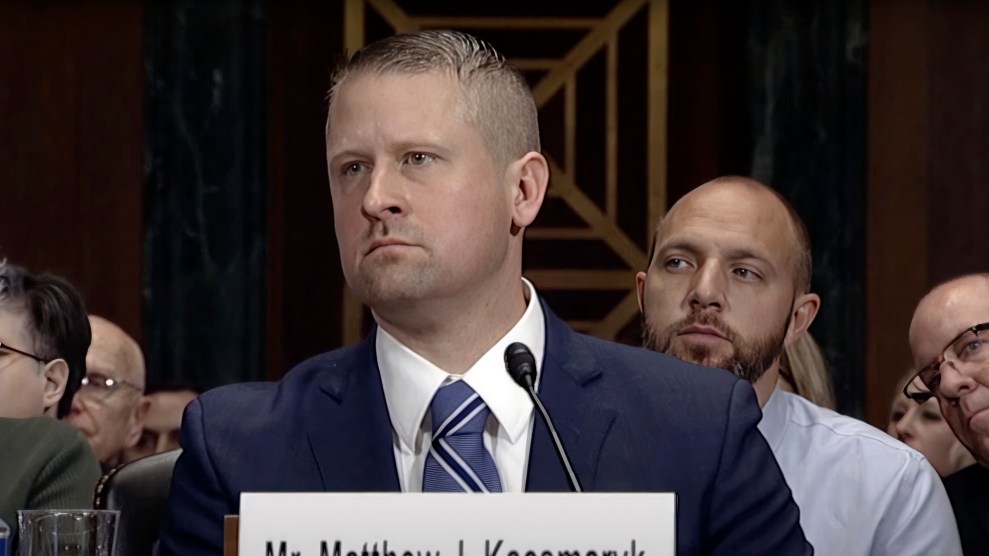
Mother Jones; Getty
“It was absolutely revolutionary,” Dr. Marguerite Cohen, an OB-GYN in Portland, Oregon, says. Dr. Cassing Hammond, an OB-GYN in Chicago, Illinois, describes it as a “sea change—a godsend for so many of the patients who needed it.”
These physicians are referring to the advent of mifepristone more than twenty years ago, a drug that has been approved by the regulatory bodies of more than 90 countries as part of a regimen to terminate pregnancies. Since the US Food and Drug Administration (FDA) approved its use in 2000, mifepristone has been shown to be more than 98 percent effective in its designated use as part of a two-drug protocol medication abortion. It has also proven to be effective in easing the process of a miscarriage.
But on April 7, US District Judge Matthew Kacsmaryk ruled to suspend the FDA’s authorization of mifepristone, reasoning the medication is unsafe and that its original regulatory approval was rushed. Since then, the Fifth Circuit Court of Appeals agreed to temporarily block the suspension while it considers the case, but restricted usage from 10 weeks gestation to seven—even as the World Health Organization advises mifepristone is safe to use through 12 weeks. “That’s just made up out of whole cloth,” Cohen says of the shortened window. “There’s not any medicine behind that.”
The court also revived a rule that would mandate patients to have three clinic visits with a physician in order to be prescribed the medication, a requirement that for many pregnant people could prove to be a burden.
“It’s really difficult to know that you have the scientific expertise to take care of people and to know that that’s been completely undermined by an individual,” Dr. Gabriela Aguilar, the regional medical director for Planned Parenthood of Greater New York says, “or in this case, an individual’s politics.”
At the request of the Biden Administration, the US Supreme Court stepped in on Friday and temporarily placed all of the restrictions on mifepristone on hold through Wednesday night. What happens next is anybody’s guess: The Supreme Court could say the restrictions on mifepristone are paused until the Fifth Circuit issues its final decision, or the Supreme Court could decide to review the case in full itself. If the restrictions are ultimately applied, it may take months for mifepristone manufacturers to update their labels to meet the new guidelines: a period in which the drug may not be available. In the meantime, the availability of a drug that revolutionized abortion care and miscarriage management hangs in the balance—even in states where abortion is legal.
But what would reproductive healthcare in America look like without mifepristone? To answer that question, Mother Jones interviewed five physicians and reproductive health experts. Abortion would still be safe without the medication, they said, but their patients would have to choose between more invasive surgical treatments or a more uncomfortable and less effective medication option. Today, medication abortions—usually through the combination of mifepristone and misoprostol—account for more than half of all abortions in the US.
“The experience for patients is going to be awful,” says Amy Hagstrom Miller, the founder of Whole Woman’s Health, a network of independent abortion clinics. “People deserve better.”
What is mifepristone and how does it work?
Mifepristone is a pill that works by blocking a hormone called progesterone, which the uterus needs to prepare and maintain a pregnancy. Without enough progesterone, the lining of the uterus breaks down and the pregnancy stops developing. The standard regimen for medication abortions in the US and other developed countries is to take one 200 mg dosage of mifepristone, followed 24 to 48 hours later by 800 mg of misoprostol, which causes the cervix to soften, dilate, and contract, expelling the contents of a pregnancy.
What alternatives exist if mifepristone is restricted or its approval is suspended?
It will still be possible to have a medication abortion using more doses of misoprostol alone. Misoprostol-only regimens are often the only option for women in developing countries because it is inexpensive. It is also taken to prevent stomach ulcers, making it easier to obtain even in countries where most abortions are illegal.
The other alternative is a surgical abortion, in which a health care provider inserts thin rods into the vaginal canal to manually dilate the cervix, followed by metal instruments or suction tube to remove the pregnancy tissue. Surgical abortion has long been the alternative and effectively was the only option when Roe v Wade first became law.
What are the drawbacks to the alternative methods?
Misoprostol-only regimens are safe and reasonably effective: A review published by the International Journal of Gynecology & Obstetrics in 2007 found that taking misoprostol alone before 9 weeks gestation was successful in terminating a pregnancy between 84 and 96 percent of the time. But that’s less effective than the two-drug regimen, which is roughly 98 percent effective in patients up to nine weeks gestation.
Patients using the single-drug regimen will typically have to take 2-3 doses of misoprostol, in three-hour intervals, to complete the termination of pregnancy, but the process takes longer than with the combination method. “Needing to use a multi-dose misoprostol-only regimen would drag out that process,” Aguilar says. “It will also be harder for folks.”
Aguilar was referring to the fact that when using misoprostol alone, patients tend to suffer more side effects. Symptoms can include heavier bleeding, more cramping, nausea, diarrhea, and fever.
Dr. Daniel Grossman, an OB-GYN at the University of California San Francisco said that if mifepristone were completely off the market, “we could transition to using misoprostol only… But it’s not ideal.” He too pointed to the larger doses of the medication that were necessary and the increased likelihood of unpleasant side effects. Also, because misoprostol is slightly less effective on its own, Grossman says more patients may require aspiration procedures to finish expelling the uterus contents that did not pass with misoprostol.
Surgical abortions are the other alternative. They are resoundingly safe and have some additional upsides: they can require fewer in-person clinic visits, the procedure itself can take as little as five minutes, and the method is marginally more effective than medication abortions, especially as the gestational age increases. But surgical abortions can also be more labor-intensive and expensive than medication abortions and carry their own health risks: infection, heavy bleeding, a tear in the wall of the uterus, and injury to the cervix.
How might the absence of mifepristone affect people suffering pregnancy loss?
Mifepristone is used not only for abortions but also for managing miscarriages and stillbirths. A 2018 article in the New England Journal of Medicine showed that miscarrying patients were 17 percentage points more likely to expel all the contents of the pregnancy when they were given mifepristone and misoprostol than when they were given misoprostol alone. The higher success rate meant that fewer of them had to undergo aspiration to clear their uteruses of remaining pregnancy tissue.
If a miscarriage occurs early in the pregnancy, the combination of mifepristone and misoprostol can be taken at home, an option, Grossman says, that can be helpful to patients who “are having a lot of emotions around the loss of pregnancy.” Pregnancy losses occurring at a higher gestational age sometimes have to be passed in a clinical setting. In these cases as well, mifepristone is helpful in expediting the delivery of fetal remains.
“It can literally take days to get somebody induced, and during those prolonged time periods, their risk of hemorrhage and other complications goes up,” says Hammond. “When I was in training in the late-1980s, we saw that. We would try older induction agents all the time and some patients delivered well, but for other patients, it was a long, agonizing process.”
Misoprostol, which was originally designed to prevent NSAID-induced stomach ulcers, began being used off-label as an induction agent in the 1990s. It helped shorten the time it took to pass pregnancy remains to 12-18 hours, Hammond recalls. But then the addition of mifepristone shortened the duration even further: “If you treat with mifepristone prior to giving the misoprostol,” he says, “the medium induction intervals are roughly cut in half. It is more on the order of six to nine hours.” He estimates that the inductions would be “at least twice as long” should they return to the misoprostol-only regimen.
How would restrictions on mifepristone affect clinicians?
Because medication abortions using misoprostol alone tend to generate more symptoms, some doctors expect patients will be more likely to contact their offices with concerns after taking the medication. This would mean more follow-up appointments at the clinic and more phone consultations, overloading already strained clinic staff.
If mifepristone is limited, Aguilar also expects more people to opt for surgical procedures in hopes of avoiding the side effects of a misoprostol-only regimen. “We’re also preparing for the fact that folks might hear this information and no longer be interested in medication abortion,” she says, “so we’re preparing for having to do more procedures if interest in medication abortion dwindles.”
Despite the courts’ restrictions on mifepristone currently being on hold, the workloads of OB-GYNs and their clinics are already increasing as they try to come up with safe and effective care plans that keep patients as comfortable as possible while complying with increasingly stringent, and often uncertain, legal codes. But depending on how the courts rule, these two goals may no longer be compatible.
“Doctors are stuck between what the law is and what medical practice is,” Cohen says. “It’s a disaster.”
Additional reporting was provided by Madison Pauly.












